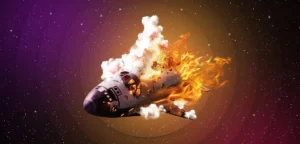After a perfect launch, spectators try to catch a last glimpse of Space Shuttle Columbia, barely visible at the top end of the twisted column of smokes
Closed quarters, vehicles faster than the speed of sound, zero gravity, and extremely volatile rockets. Do any of these things sound particularly prone to accidents? Space travel is tricky work that takes careful calculations and even more careful actions when situations get tough. Here is a list of seven accidents and disasters that have occurred during space expeditions.
The International Space Station (ISS), imaged from the space shuttle Endeavour December 9, 2000, after installation of a large solar array (long horizontal panels). Major elements of the partially completed station include (front to back) theAmerican-bui
International Space StationThe International Space Station (ISS) was built in sections beginning in 1998. By December 2000 the major elements of the partially completed station included the American-built connecting node Unity and two Russian-built units—Zarya, a power module, and Zvezda, the initial living quarters. A Russian spacecraft, which carried up the station’s first three-person crew, is docked at the end of Zvezda. The photograph was taken from the space shuttle Endeavour.
National Aeronautics and Space Administration
Luca Parmitano, an Italian astronaut with the European Space Agency, took on a bit of water as he was working outside of the International Space Station (ISS) on July 16, 2013. During a spacewalk on the 36th expedition to the ISS, Parmitano’s helmet began to unexpectedly fill with liquid, and, being in space, the water was free to float around his entire head, eventually making it impossible for him to hear or speak to the other astronauts. Though it might seem like the solution to Parmitano’s problem was obvious, alas, the water was not from a drinking bag but from a leak in a liquid coolant system and would not have been the safest thing to drink. Plus, imagine drinking water that is floating freely in the air—doesn’t seem so easy. The spacewalk continued for over an hour before he was back in the ISS and free from his wetsuit, completely unharmed but in need of a fresh towel (which he received promptly). The accident and subsequent cancellation of the spacewalk made it the second shortest spacewalk in the station’s history.
The space shuttle Challenger disaster that occurred on January 28, 1986, marked one of the most devastating days in the history of space exploration. Just over a minute after the space shuttle lifted off, a malfunction in the spacecraft’s O-rings—rubber seals that separated its rocket boosters—caused a fire to start that destabilized the boosters and spread up the rocket itself. The shuttle was moving faster than the speed of sound and quickly began to break apart. The disaster led to the deaths of all astronauts on board, including civilian Christa McAuliffe, a participant in NASA’s Teacher in Space project who was to teach classes and perform experiments while in space. The extended mission of the shuttle included deployment of satellites and the test of tools for studying astronomy and Halley’s Comet. The shuttle’s launch was not widely televised, but the explosion and breakup of the shuttle was visible to spectators on the ground. The launch itself, performed in 26 °F (−3 °C) weather, was predicted to encounter issues by members of the engineering team who knew of the dangers posed to O-rings by such low temperatures. Despite vocalizing these concerns, the mission continued as planned because NASA was against delaying the shuttle’s launch any more, as it had already been delayed multiple times. The disaster resulted in the temporary suspension of the space shuttle program and the creation of the Rogers Commission to determine the cause and fault of the disaster







